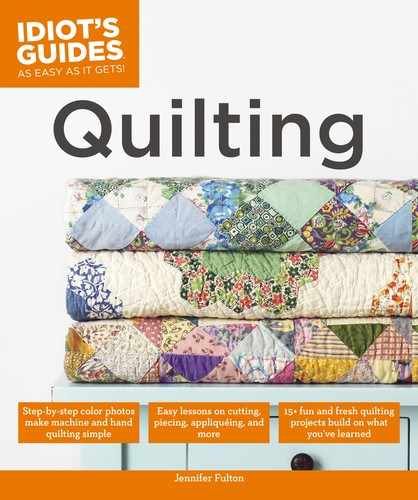
170
CHAPTER PREPARING A QUILT FOR QUILTING
Baste Quilt Layers
If you plan to do your own quilting, you must first baste the layers of your quilt together. Basting
temporarily holds the backing, batting, and quilt top in place, and prevents them from shiing during
quilting. You can baste using thread, safety pins, or straight pins (with foam caps that cover the tips).
If you’re machine quilting, you can
also baste layers together using a
fusible batt. After layering, iron the
top and then the back to fuse the three
layers together.
Prepare the top and backing.
Cut the selvages o the backing (if you didn’t before). Press the backing and top with starch. Staystitch around the perimeter
of the top a scant
1
⁄
4
inch (.6 cm) from the edges, to stabilize them. Fold the back and top into quarters and mark the center
of each side with a safety pin.
Thread basting uses long, loose stitches to keep the
layers together, and is a good choice for hand quilting
or intricate machine quilting because it keeps pins
out of the way. You remove the basting stitches aer
quilting, so use a thread that contrasts with your top
for better visibility.
Pin basting uses safety pins or straight pins with foam
caps to hold the quilt layers in place, and works well
for machine quilting.
1
Staystitched
edge

171
BASTE QUILT LAYERS
Tape or clip the backing to your floor or table.
Lay the backing right side down, flatten and stretch it taut,
and then secure it in place by taping or clipping it to the work
surface every 8 inches (20 cm) or so.
2
Layer the batting and quilt top.
Fold the batting into quarters. Lay it flat on the backing,
matching the folds in the batting with the safety pins on the
backing along each edge. Smooth any folds. Then place the
quilt top gently on top, right side up. Match the safety pins
on the sides of the top and back and smooth any wrinkles.
3
If your quilt is bigger than your table
or floor space, work in quadrants. Pin
the top-left quadrant first. Then shift
the quilt sandwich carefully, tape or
clip the back again, and pin the next
quadrant.
Backing
Batting
Quilt top
The backing will extend beyond the
quilt top by 3 to 4 inches (7.6 cm)
on all sides. The batting should be
slightly smaller than the backing,
about 1 to 1
1
⁄
2
inches (2.5–4 cm) larger
than the quilt top on all sides.

172
CHAPTER PREPARING A QUILT FOR QUILTING
To thread baste: Thread a darning, upholstery, basting, or
curved needle with cotton or cotton/polyester thread. Don’t
knot the thread. Start at the center of the top edge, and take
long, loose stitches through all layers to the bottom edge,
being careful not to let the layers shift. Baste across the
center horizontally from edge to edge, and then continue
basting horizontally, vertically, and diagonally 4 inches
(10cm) apart.
4
To pin baste: Pin using 1
1
⁄
4
-inch (3.8 cm) or 2-inch (5.1 cm)
safety pins or straight pins through all layers in a grid about
4inches (10 cm) apart, being careful not to let the layers
shift. Pin in places where you won’t be quilting if possible.
Close the safety pins or cover the tips of the straight pins
with foam caps as you go.
Baste the edges to stabilize them.
Trim the batting and backing, leaving 2 inches (5 cm) around
the perimeter of the top. After removing the pins used to
center the layers, roll the backing back up over the batting
and the edge of the top to protect the raw edges. Baste the
rolled edge down with large hand stitches. This stabilizes the
edge, which will be handled frequently as you quilt.
5
If closing many safety pins becomes
painful for your fingers, use a Kwik Klip,
the back of a spoon, or the edge of a
knife to guide the pin tip into the
closure.
Pin or thread baste in a grid 4 inches (10 cm) apart.

173
BASTE QUILT LAYERS
..................Content has been hidden....................
You can't read the all page of ebook, please click here login for view all page.
